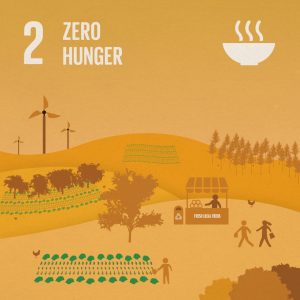If you’re one of the 19 million people in the United States who lives in a food desert, getting access to fresh, healthy food, particularly fresh produce, can be extremely difficult. Food deserts are defined as places where predominantly low-income people live at least 1 mile from a grocery store (or at least 10 miles for those in rural areas). Farmers’ markets are often not a viable solution due to distance, cost, limited hours of operation, and limited selection of goods. So, what are food insecure people to do if they want affordable, accessible, and nutritional food? Why, start a garden, of course! Even better, start or join a community garden!

Auburn’s Community Garden logo
What are community gardens?
Community gardens are simply places where a group of people collectively grow food. They can be privately owned (like by a neighborhood association or a church) or public (such as gardens at schools or community centers). They can be located rurally or in a dense urban areas, and members can be all ages. Regardless of where they are and who makes them up, community gardens represent a great opportunity for people of all socio-economic backgrounds to grow nutritious food, improve their mental and physical health, improve their communities, and connect with their neighbors.
Physical health benefits of gardening:

A group of friends posing with their gardening tools before getting back to work in the garden.
- Improved nutrition
- Increase in physical activity
- Decrease in obesity
Mental health benefits of gardening:
- Increase in your sense of community
- Decrease in anxiety and depression
- Decrease in overall stress (Who doesn’t need a little less stress in their life, especially in 2020?)
Why eat locally?
Food in the United States travels about 1,500 miles from farm to plate. It takes days and sometimes weeks to get to you from where it was grown, and most produce loses 30 percent of nutrients in the first 3 days after harvest. Not to mention the alteration in taste and texture. And the exorbitant use of fossil fuels to ship, fly, or truck your food to the grocery store. Growing your own food, buying from local farmers, and eating seasonally are all ways you can increase your food’s nutrients and decrease your carbon footprint.

Friends harvest pumpkins and watermelon grown in the garden.
What is Auburn University doing?
Many food insecure people also attend college campuses, making this a critical issue for universities. Amazingly, Auburn University has been invested in community and student health through our campus community garden for more than 50 years! Did you know you can rent a plot or volunteer at our garden any time? Whether it’s just your excuse to get out of the house for a couple of hours, or a reason to get a group of friends together during the pandemic, you can get your hands in the dirt and help grow food for your community any time at the community garden. So far in 2020, with the help of our volunteers and donors, we have grown and donated over 1,000 lbs of produce! Or do you want to learn how to start your own garden at home? Whether you have a yard, a balcony, or just a sunny windowsill, the Community Garden at AU has classes, workshops, and online resources to help you get growing.
Even just being in a campus green space has been shown to improve college students’ quality of life, so come visit the garden soon. We can’t wait to see you there!
Visit the community garden website or email the garden manager Marley to learn more!
Sources and further reading:
Campus Green Spaces Enhance Quality Of Life. Retrieved from ScienceDaily
Research Regarding the Benefits of Community Gardens. Retrieved from NC State Extension
Center for Urban Education about Sustainable Agriculture. (n.d.). How Far Does Your Food Travel to Get to Your Plate?
Most produce loses 30 percent of nutrients three days after harvest. Retrieved from Chicago Tribune
Impact of Gardening on Mental Health. Retrieved from Healthy Minds Philly
Food Access Reserach Atlas. Retrieved from USDA Economic Research Service
Post contributed by Marley Halter, Manager of the Community Garden at Auburn University.
Learn about the SDGs & AU and our contributions related to this post.





